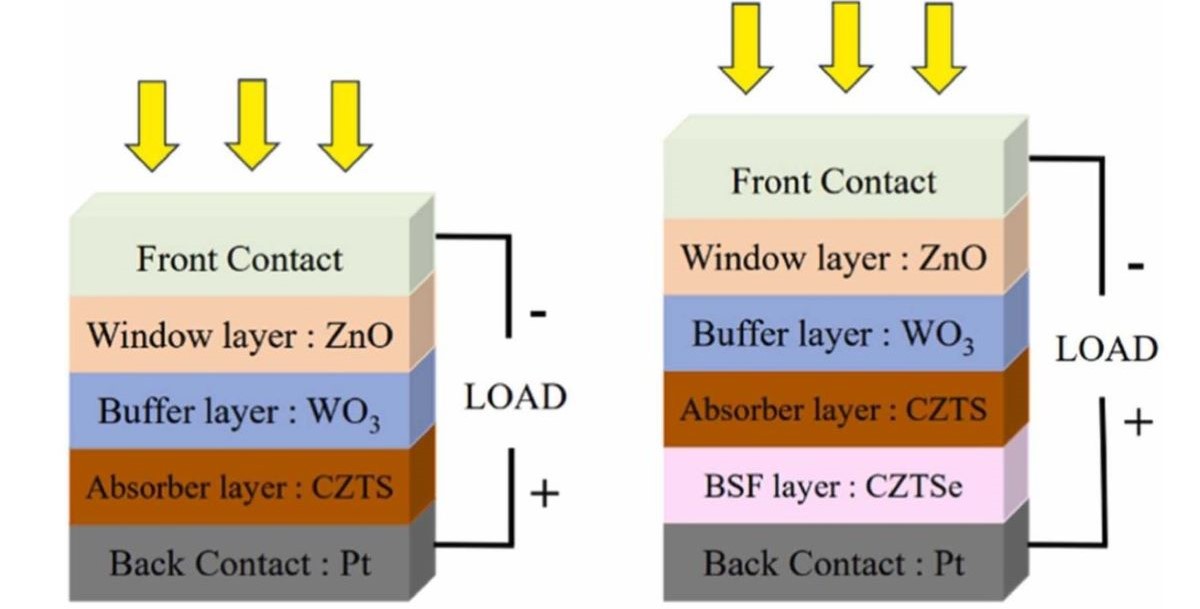A group of researchers from China and Malaysia has proposed a new structure for copper zinc tin sulphide (CZTS) thin film solar cells in a bid to improve efficiency and use more environmentally-friendly materials.
The team chose tungsten oxide (WO3) as a buffer layer based on its properties and performance uncovered in earlier research, such as its high bandgap and “excellent electrical conductivity,” It was used to replace the cadmium sulfide (CdS) buffer layer, which the team said is toxic and has a high cost. In addition, the team chose to apply a back surface field (BSF) based on Cu2ZnSnSe4 (CZTSe) between the absorber layer and the metal substrate Platinum (Pt).
In the study, one device was structured without the BSF layer, with zinc oxide (ZnO) as the window layer, WO3 as the buffer layer, CZTS as the absorber layer, and Pt metal substrate, noted by the researchers as Pt/CZTS/WO3/ZnO structure. The other device was similarly structured but with an additional CZTSe BSF layer sandwiched between the CZTS and Pt layers, which was noted as Pt/CZTSe/CZTS/WO3/ZnO structure.
The group then analyzed the structures with and without the BSF layer. It investigated how the layer thickness, operating temperature, back contact layers, acceptors, and defects in the BSF layer affected the performance using SCAPS-1D solar cell capacitance software, developed by the University of Ghent.
Comparison between the two structures demonstrated that the addition of the BSF layer could increase the erformance of the CZTS solar cell. The best results of the Pt/CZTSe/CZTS/WO3/ZnO device indicated an open circuit voltage of 1.2 V, a fill factor of 83.37%, and a power conversion efficiency of 29.3%. This was an improved result compared to the solar cell without a BSF layer, which had an efficiency of 23.01%, according to the team.
In concluding remarks, the scientists said that in industrial practices it is necessary to consider material costs, environmental sustainability, and material defect density to achieve large-scale production. “Future research should focus on advancing the development and stability of multi-heterojunction solar cells, exploring metal ion doping, and improving thin film techniques,” they said, asserting that this research ought to provide a new way to improve the performance of similarly structured solar cells to enable the industrialization of low cost and high-efficiency PV cells.
The research is documented in “Efficiency enhancement of CZTS solar cell with WO3 buffer layer using CZTSe BSF layer,” published in Energy Reports. The research team had scientists from China-based Wuhan University, Malysia-based Multimedia University, and Xiamen University Malaysia.
This content is protected by copyright and may not be reused. If you want to cooperate with us and would like to reuse some of our content, please contact: editors@pv-magazine.com.



1 comment
By submitting this form you agree to pv magazine using your data for the purposes of publishing your comment.
Your personal data will only be disclosed or otherwise transmitted to third parties for the purposes of spam filtering or if this is necessary for technical maintenance of the website. Any other transfer to third parties will not take place unless this is justified on the basis of applicable data protection regulations or if pv magazine is legally obliged to do so.
You may revoke this consent at any time with effect for the future, in which case your personal data will be deleted immediately. Otherwise, your data will be deleted if pv magazine has processed your request or the purpose of data storage is fulfilled.
Further information on data privacy can be found in our Data Protection Policy.